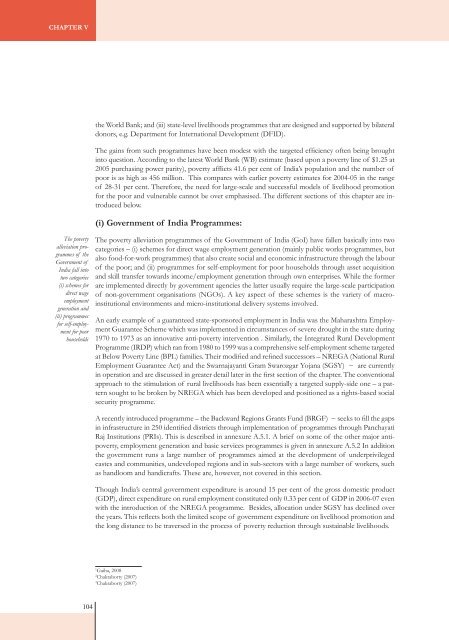SOIL Report 2008 - ACCESS Development Services
SOIL Report 2008 - ACCESS Development Services
SOIL Report 2008 - ACCESS Development Services
You also want an ePaper? Increase the reach of your titles
YUMPU automatically turns print PDFs into web optimized ePapers that Google loves.
Chapter Vthe World Bank; and (iii) state-level livelihoods programmes that are designed and supported by bilateraldonors, e.g. Department for International <strong>Development</strong> (DFID).The gains from such programmes have been modest with the targeted efficiency often being broughtinto question. According to the latest World Bank (WB) estimate (based upon a poverty line of $1.25 at2005 purchasing power parity), poverty afflicts 41.6 per cent of India’s population and the number ofpoor is as high as 456 million. This compares with earlier poverty estimates for 2004-05 in the rangeof 28-31 per cent. Therefore, the need for large-scale and successful models of livelihood promotionfor the poor and vulnerable cannot be over emphasised. The different sections of this chapter are introducedbelow.(i) Government of India Programmes:The povertyalleviation programmesof theGovernment ofIndia fall intotwo categories(i) schemes fordirect wageemploymentgeneration and(ii) programmesfor self-employmentfor poorhouseholdsThe poverty alleviation programmes of the Government of India (GoI) have fallen basically into twocategories – (i) schemes for direct wage employment generation (mainly public works programmes, butalso food-for-work programmes) that also create social and economic infrastructure through the labourof the poor; and (ii) programmes for self-employment for poor households through asset acquisitionand skill transfer towards income/employment generation through own enterprises. While the formerare implemented directly by government agencies the latter usually require the large-scale participationof non-government organisations (NGOs). A key aspect of these schemes is the variety of macroinstitutionalenvironments and micro-institutional delivery systems involved.An early example of a guaranteed state-sponsored employment in India was the Maharashtra EmploymentGuarantee Scheme which was implemented in circumstances of severe drought in the state during1970 to 1973 as an innovative anti-poverty intervention . Similarly, the Integrated Rural <strong>Development</strong>Programme (IRDP) which ran from 1980 to 1999 was a comprehensive self-employment scheme targetedat Below Poverty Line (BPL) families. Their modified and refined successors – NREGA (National RuralEmployment Guarantee Act) and the Swarnajayanti Gram Swarozgar Yojana (SGSY) − are currentlyin operation and are discussed in greater detail later in the first section of the chapter. The conventionalapproach to the stimulation of rural livelihoods has been essentially a targeted supply-side one – a patternsought to be broken by NREGA which has been developed and positioned as a rights-based socialsecurity programme.A recently introduced programme – the Backward Regions Grants Fund (BRGF) − seeks to fill the gapsin infrastructure in 250 identified districts through implementation of programmes through PanchayatiRaj Institutions (PRIs). This is described in annexure A.5.1. A brief on some of the other major antipoverty,employment generation and basic services programmes is given in annexure A.5.2 In additionthe government runs a large number of programmes aimed at the development of underprivilegedcastes and communities, undeveloped regions and in sub-sectors with a large number of workers, suchas handloom and handicrafts. These are, however, not covered in this section.Though India’s central government expenditure is around 15 per cent of the gross domestic product(GDP), direct expenditure on rural employment constituted only 0.33 per cent of GDP in 2006-07 evenwith the introduction of the NREGA programme. Besides, allocation under SGSY has declined overthe years. This reflects both the limited scope of government expenditure on livelihood promotion andthe long distance to be traversed in the process of poverty reduction through sustainable livelihoods.1Gaiha, <strong>2008</strong>2Chakraborty (2007)3Chakraborty (2007)104














